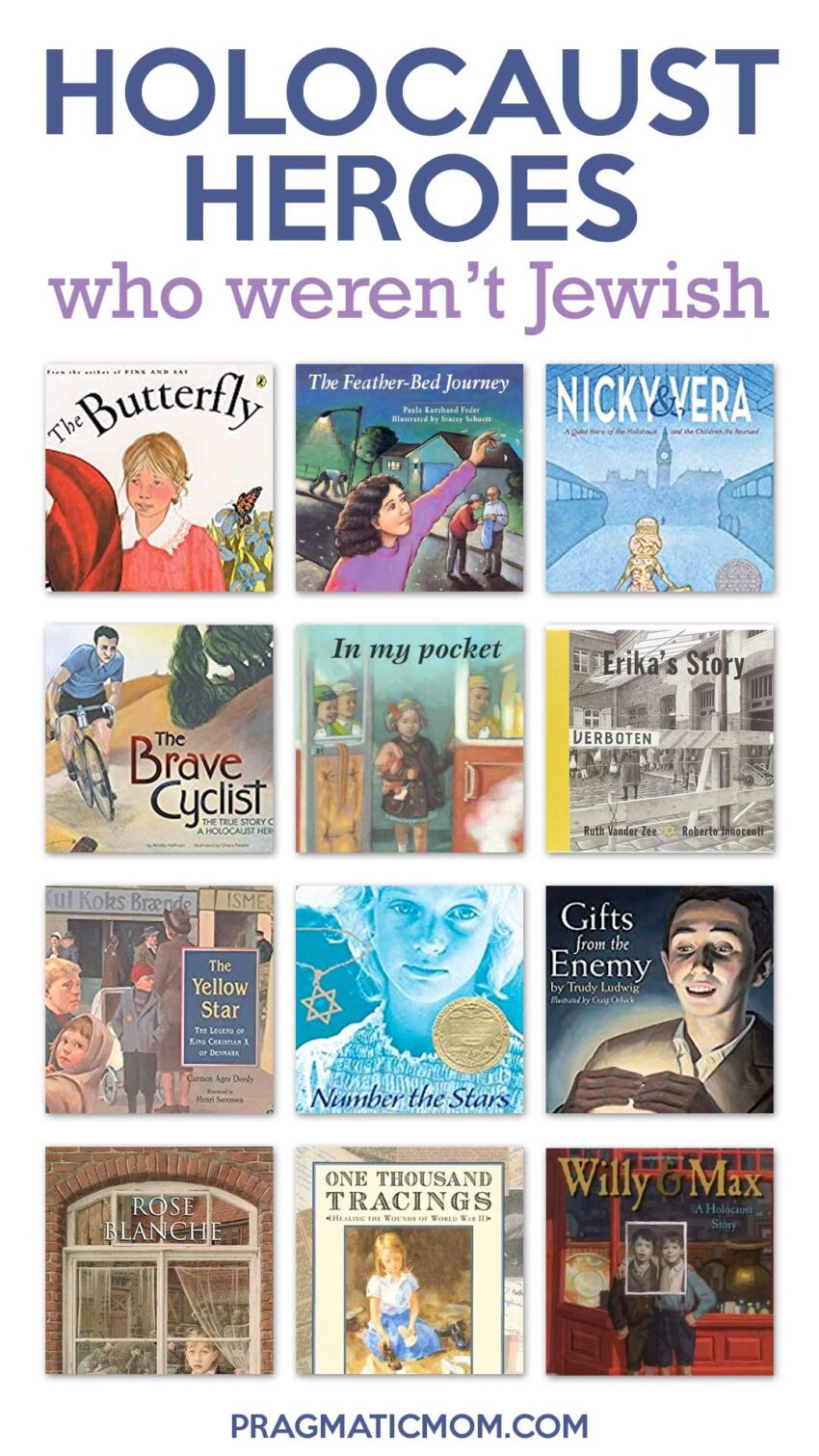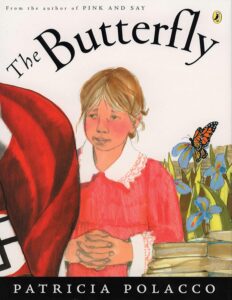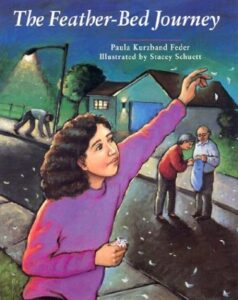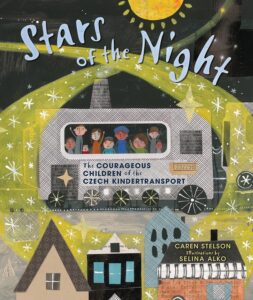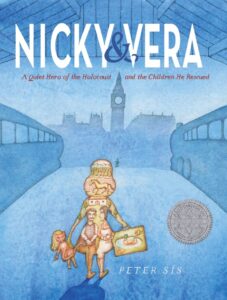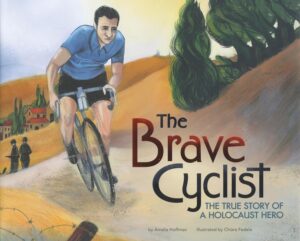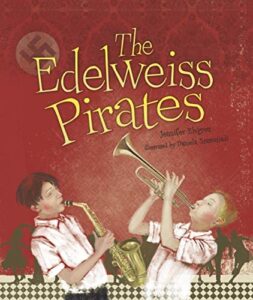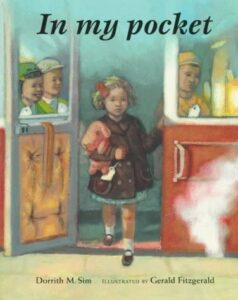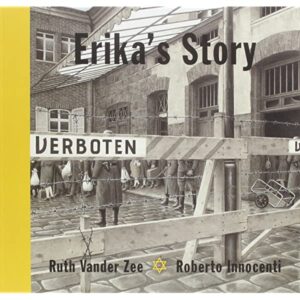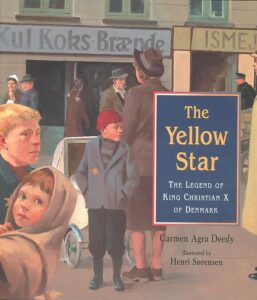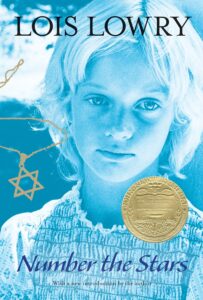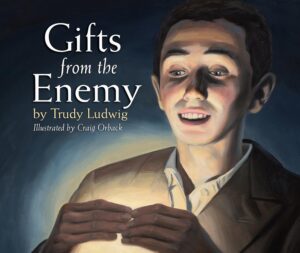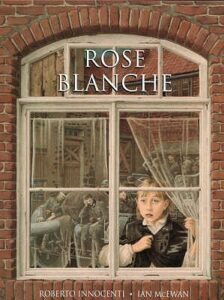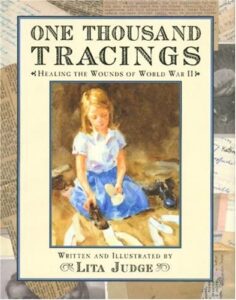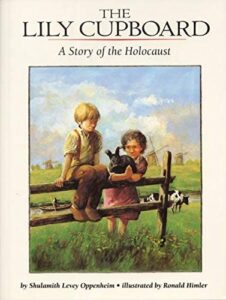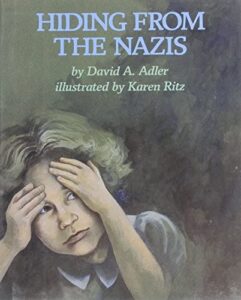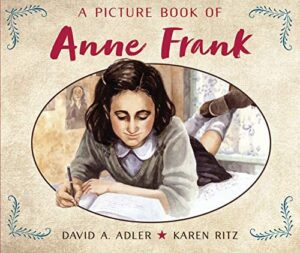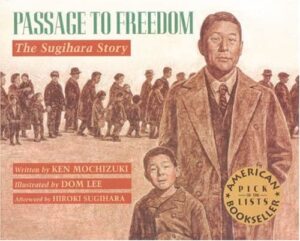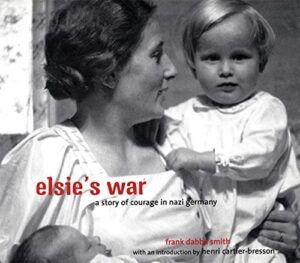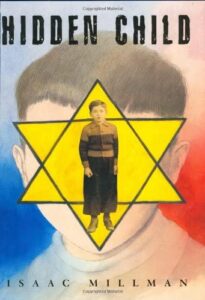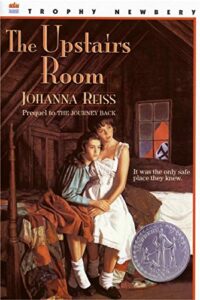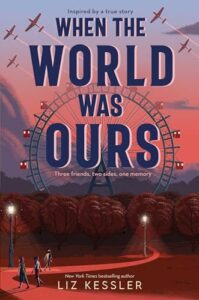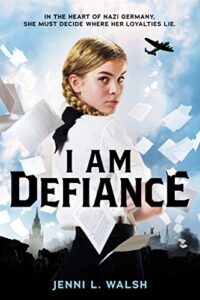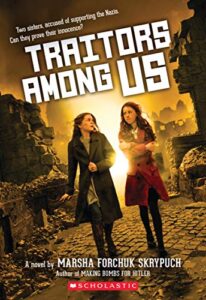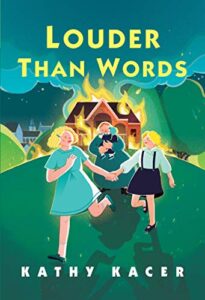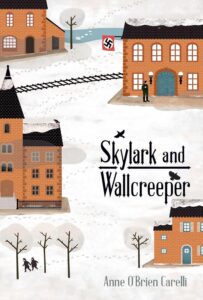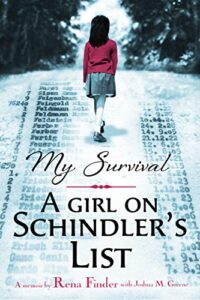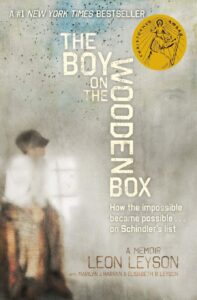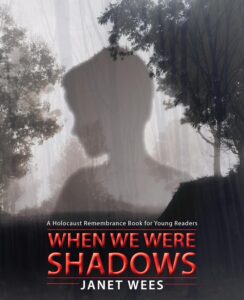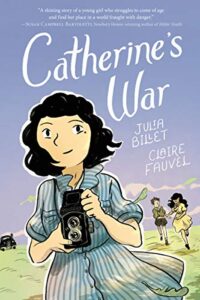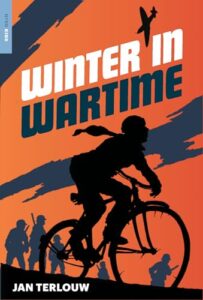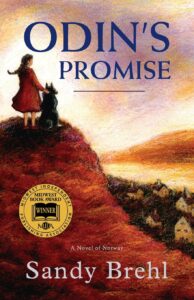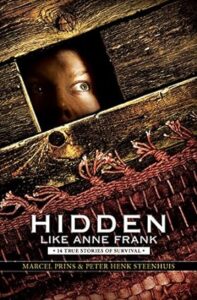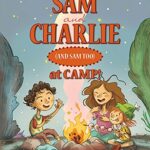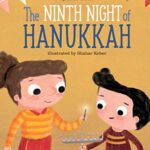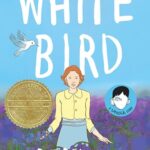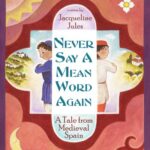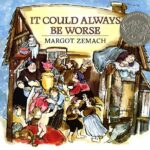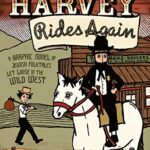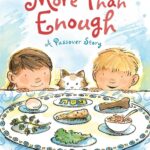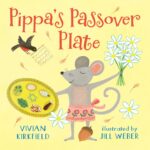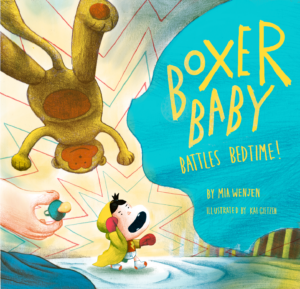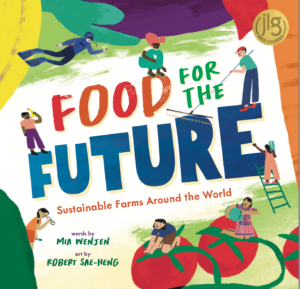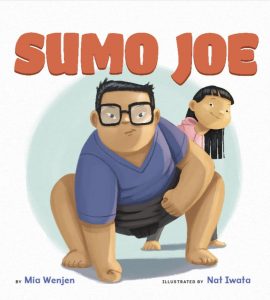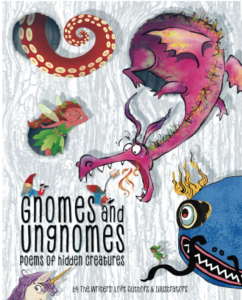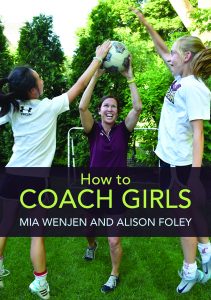Artists 4 Israel has a global mural project that honors the Righteous Among the Nations. This project educates the next generation about The Holocaust through murals, street art, film, social media, public works, and more. I am honored to contribute to this project with children’s and young adult books that focus on Holocaust heroes who weren’t Jewish.
For more information about the Righteous Among Nations, please go to the Holocaust remembrance center, Yad Vashem, for a great resource here.
I hope to find more books to include on this list. Thank you for your suggestions!
32 Holocaust Resistance Heroes Who Weren’t Jewish
The Butterfly by Patricia Polacco
Nazi soldiers were everywhere in Monique’s small village in France. One night, she discovered a little girl, Severine, at the foot of her bed. Her parents were hiding her and other Jews in their basement. Monique and Sevrine become friends and play secretly together until one terrible night when they are spotted from their window. Sevrine and her parents must separate and flee.
This is the true story of Patricia Polacco’s great aunt, Marcel Solliliage, who was part of the French underground resistance movement. Sevrine survived and, after the war, relocated to the new state of Israel. Her parents did not survive their escape. Sevrine and Monique continued their friendship to this day. [picture book, ages 6 and up]
The Feather-Bed Journey by Paula Kurzband Feder, illustrated by Stacey Schuett
There had always been a history of anti-Semitism in Poland, but the treatment of Jews became much worse during the occupation…The Nazis also persecuted Gypsies, homosexuals, Communists, Jehovah’s Witnesses, the disabled, and the mentally ill.
Rachel’s grandmother had a pillow filled with down feathers that she treasured. When her grandchildren ripped the pillow, scattering the feathers, she was distraught. Rachel’s grandfather comforted her by telling her that the pillow will become smaller, prompting a story about how the pillow was once a feather bed. The feather-bed story begins in Poland, with Freydl Rochovitsky, the great-grandmother, who made the feather bed with down plucked from her geese. Her family was forced into the ghetto by the Nazis who invaded Poland. Her family arranged for her to escape through a hole in the ghetto wall, arranging for a farmer to hide her. Despite hiding in a secret compartment in the basement most of the time, she was spotted by a neighbor peeking out the window. She had to move to another family who hid her for two more years. At last, the war ended, and she was able to reunite with her mother and resettle in America. The feather pillow found her there on the last day of Hanukkah, sent by the first farmer, Jan Witkowski, who hid her. This is a true story. [picture book, ages 5 and up]
We can talk to our children about prejudice and its results. We can point out the devastation of war. Perhaps, most important, we can talk about courage and acts of goodness in the midst of horror.
Then it will be our children, armed with an understanding of the past, who can stand up and say, Never again. Paula K. Feder
Stars of the Night: The Courageous Children of the Czech Kindertransport by Caren Stelson, illustrated by Selina Alko
I discovered this picture book through A Kids Book A Day :
This powerful story is told from the collective perspective of the children who were rescued from Czechoslovakia on the eve of World War II, as Hitler’s campaign of hatred toward Jews and political dissidents took hold. The narrative starts in 1938 and follows the children as they journey to foster families in England for the duration of the war, return to Prague afterward in an unsuccessful search for their parents, and eventually connect with Nicholas Winton, a British former stockbroker who was instrumental in bringing them to safety. Winton and the Czech Kindertransport ultimately rescued 669 children from Nazi persecution.
“This story is told from the children’s perspective, so Nicholas Winton is simply a mysterious man, as he would have been to them. His story is so interesting, though, that it seems a shame to relegate him to the back matter. For a different perspective, be sure to check out Peter Sis’s Nicky and Vera.”
The Czech Kindertransport led by Nicholas Winton ultimately rescued 669 Jewish children. They were rescued from Czechoslovakia and fostered by families in England right before WWII in 1938 through the end of WWII. [picture book, ages 8 and up]
Nicky & Vera: A Quiet Hero of the Holocaust and the Children He Rescued by Peter Sis
An ordinary citizen, Nicholas Winton, changed plans from a ski vacation to rescuing Jewish children in Prague. He was a Brit who saw what needed to be done and set about, in a foreign country, to raise money, find foster families and help Jewish children resettle in Great Britain. Vera was one of those children who he saved. Peter Sis weaves their stories together in this true story of an unsung hidden hero of the Holocaust. [picture book ages 6 and up]
The Brave Cyclist: The True Story of a Holocaust Hero by Amalia Hoffman, illustrated by Chiara Fedele
This is the true story of Italian cyclist Gino Giovanni Bartali. Born sickly and into poverty, he nonetheless was determined to race on a bicycle. After winning his first Tour de France in 1938, he was recruited for a secret and dangerous mission to save Jewish lives.
His friend, a Cardinal in the Catholic church, needed his cycling skills to smuggle false identification cards to help Jewish people escape to safety. Gino risked his life for this cause, ending up in jail for three days. When the war ended, Gino faced another challenge.
This time it was to compete in the Tour de France again. He won his second Tour de France at age 34. His acts of heroism, modestly hidden away, now shine beside his athletic achievements. [picture book, ages 9 and up]
The Edelweiss Pirates by Jennifer Elvgren, illustrated by Daniela Stamatiadi
By 1938, open anti-Semitism became increasingly accepted throughout Germany, including in public schools. Portraits of Adolf Hitler hung in all classrooms. Students saluted Hitler at the start of school. They read books and played games that made fun of Jews. Teachers and students verbally and physically punished Jewish students.
In 1938, jazz music was forbidden in Germany and the Hitler Youth Patrol will harm anyone breaking the rules. Albert and his friends are part of the Edelweiss Pirates, a group of young people who play jazz and find other ways to defy the Nazis. Albert’s younger brother, Kurt, wants to join the Edelweiss Pirates but his brother thinks that he is too young. Kurt’s friend, Albert, is tormented at school for being Jewish. In an act of defiance, Kurt plays jazz on his trumpet at the school band concert. The Edelweiss Pirates join in. The Edelweiss Pirates were a group of more than 5,000 young dissenters in western Germany. [picture book, ages 8 and up]
In 2005, Germany officially recognized the Edelweiss Pirates as a resistance group, a tribute to those young people who dared to stand up to Nazi tyranny.
In My Pocket by Dorrith M. Sim, illustrated by Gerald Fitzgerald
There is a frustrating lack of statistical data concerning the Kindertransport, but it is now estimated that only about half of the 10,000 saw one or both of their parents again.
It is too simplistic to see the Kindertransport purely as a success story. Around 10,000 human lives were saved, but many paid a heavy price. Even those families that were able to reunite were often broken beyond repair.![]() from Aberystwyth University
from Aberystwyth University
Author Dorrith M. Sim was a seven-year-old on the Kindertrasport out of Nazi Europe. They escaped in 1939, first by train from Hamburg, Germany to Holland. From there, they took a boat to England. Another train took them to London. Dorrith was cared for by a Scottish couple until she could be reunited with her parents. Not all the children were that lucky. [picture book, ages 6 and up]
Erika’s Story by Ruth Vander Zee, illustrated by Roberto Innocenti
When Erika was an infant, her parents were herded to a cattle car at the railroad station in Germany. Did they know that they would be taken to a concentration camp? Her mother, on her way to death, threw her baby out of the cattle car, onto a patch of grass just past a railway crossing. Someone, risking his or her life, found the baby and took her to a woman who named the baby “Erika” and raised her with love. This is a true story. [middle grade, ages 6 and up]
The Yellow Star: The Legend of King Christian X of Denmark by Carmen Agra Deedy
What if the good and strong people of the world stood shoulder to shoulder, crowding the streets and filling the squares, saying, “You cannot do this injustice to our sisters and brothers, or you must do it to us as well.” What if?
After the Nazis invaded Denmark, they flew the swastika flag from the palace. King Christian X sent a Danish soldier to remove it. When the Nazis threatened to kill the next soldier who removed their flag, King Christina X said that he would be that soldier. The Nazi flag stayed down. When the Nazis ordered Jews to wear a yellow star on their clothing, King Christian X had a plan. Every Dane wore the yellow star to protect the Jews. While there is no authenticated proof that this happened, no Jews in Denmark were forced to wear the yellow star.
Denmark was the only country in Nazi-occupied Europe to rescue the majority of its Jewish population. “The Helsingor Sewing Club” smuggled over 7,000 Jews to Sweden in fishing boats. The Danish government also interceded to save the almost 500 Jews who were deported to Theresienstadt. All but 51 survived. [picture book, ages 6 and up]
Number the Stars by Lois Lowry
My 5th grader highly recommends this historical fiction chapter book about the Danish king who saved his Jewish subjects during the German occupation. The idea of a king who stands up to Hitler feels like a fairy tale but is, in fact, true.
Here are some facts from the back pages of The Yellow Star: The Legend of King Christian X of Denmark by Carmen Agra Deedy
Among the Nazi-occupied countries, only Denmark rescued the overwhelming majority of Jews. Over 7,000 Danish Jews were smuggled to Sweden in fishing boats, 12 to 14 at a time, by a group of Danes called the “Helsingor Sewing Club.” Of the almost 500 Jews deported to Theresienstadt, all but 51 survived due in large part to the Danish government’s intercession on their behalf.
And some think … “The Danish people and their elected officials showed that with a minimal amount of resistance to Nazi programs and deportations, their plans for genocide could have been thwarted.” [middle grade, ages 9 and up]
Gifts from the Enemy by Trudy Ludwig, illustrated by Craig Orback
In the Second World War, every Jew was a victim, but not every victim was a Jew. Priests, clerics, Jehovah’s Witnesses, Roma, Afro-Germans, Russians, Czechs, Poles, Serbs, political dissidents, people with disabilities, and many others were also on Hitler’s hate list.
In this true story about Alter Wiener, he experiences the kindness of a stranger. He and his family lived in Poland. When Hitler came into power Germany invaded Poland, he and his family suffered from the rising tide of hatred that started with words and grew into something much worse. When Alter was fifteen years old, he was taken from his home and taken to the first of five Nazi labor prison camps. Food was scarce and he thought he no longer had the will or strength to live another day.
But then, something extraordinary happened. A German factory worker hid a bread and cheese sandwich for him. This was a dangerous act for her. And she did it not just once, but thirty times. When the war ended, Alter tried to find his kind stranger but was never able to locate her. The lesson that he wishes to share is ” there are kind and the cruel in every group of people, How those you meet in life is far more important than who they are.” [picture book, ages 8 and up]
It is also my strong wish for today’s children to never give up hope in their efforts to make this world a better, more caring place for all. Alter Wiener
Rose Blanche by Roberto Innocenti and Christophe Gallaz, translated by Martha Coventry and Richard Graglia
Rose Blanche was a group of young German citizens protesting the war. They had understood what others wanted to ignore. They were all killed.
In this fictionalized story, Rose Blanche is a young girl in Germany who experiences war without understanding what is going on. She witnesses the horrors of a Nazis concentration camp and secretly brings food to the children imprisoned there. When the allied forces arrive, there is a skirmish in the woods where Rose is carrying food. Shots ring out and she perishes. [middle grade, ages 10 and up]
One Thousand Tracings: Healing the Wounds of World War II by Lita Judge
We are full of thanks to our American colleagues; their friendship lets us believe once more in the future, which otherwise lay before us in frightful darkness.
Inside the attic of the author’s grandmother’s attic was a box filled with hundreds of old letters and foot tracings cut out of newspaper. It started with a letter from their German friends, the Kramers, who lost everything in the war and lived in Germany. A care package of warm clothes, canned food, sugar, and tea was sent out to them. A letter returned with deep appreciation and a plea not to help them but others. Soon, ten letters arrived with tracings of feet and pleas for shoes … one hundred pairs! Lita Judge’s mother and grandmother got to work. They knitted socks and asked their friends for help. Those who could not afford to send new items sent gently used. One friend raised money for postage by canning and selling produce from her garden. As the requests were fulfilled, new friendships were formed. Lita Judge’s grandparents were American ornithologists who organized this relief effort by coordinating with fellow scientists. They sent out more than three thousand care packages to fifteen countries throughout Europe. This story reminds us that one person can make a difference. [picture book, ages 5 and up]
The Lily Cupboard by Shulamith Levey Oppenheim, illustrated by Ronald Himler
Miriam’s parents send her to the countryside with Nello and his parents when the Nazis take over the Netherlands. She will be safer here because Nellow and his parents are not Jewish. They have a hiding place for her; a secret cupboard painted with lilies. Miriam finds comfort in a rabbit that Nello introduces her to. When the Nazi soldiers are nearby, she hides with her rabbit in the lily cupboard. It’s a tense moment but luckily they are not found. [picture book, ages 4 and up]
Families like this one hid Jewish children for five years till the war ended, and saved many lives at the risk of their own.
Hiding from the Nazis by David A. Adler, illustrated by Karen Ritz
Ernst Baer was born in Germany but moved to Holland with his wife when Hitler came to power. They thought they would be safe there, but then Germany invaded Holland in 1940. The Baers decided to hide their daughter, Lore, with another family to keep her safe. Lore stayed with the Izaak family in the city until it didn’t feel safe, and then with the Schouten family in the countryside. The local pastor knew Lore was Jewish but he made sure that she was safe. Lore hid from the Nazis for two years until the war ended and she could be reunited with her parents. This is her true story. [picure book, ages 5 and up]
A Picture Book of Anne Frank by David A. Adler, illustrated by Karen Ritz
Anne Frank was born in Frankfurt, Germany. Her father was been a German army officer during WWII. But when Adolf Hitler became Chancellor of Germany, her family moved to Amsterdam, Holland in search of safety. Holland fell to the Nazis in May of 1940, and the Frank family went into hiding in a secret apartment at his place of work when Anne’s older sister, Margot, was ordered to report to a labor camp. The Frank family hid with the Van Daan family and a dentist, Dr. Albert Dussel. Friends of the Frank family accessed the apartment to bring them food. During working hours, people were in the building. On August 4, 1944, the Nazis found out about their hiding place, and they were sent to a Nazi death camp, Auschwitz in Poland. Only Otto Frank, the father, survived. He returned to Amsterdam where he was given Anne’s diary. The secret apartment in Amsterdam is now a museum. [picture book, ages 4 and up]
Passages to Freedom: The Sugihara Story by Ken Mochizuki, illustrated by Dom Lee, afterward by Hiroki Sugihara
If you save the life of one person, it is as if you saved the world entire. — Jewish Proverb
Even a hunter cannot kill a bird that comes to him in refuge. — Japanese Proverb
Five-year-old Hiroki Sugihara is the oldest son of a Japanese diplomat stationed in Lithuania. Outside the consulate, a huge crowd of desperate people gathered. They were Jews from Poland, escaping Nazi soldiers who had invaded their country. They need his father’s help to get visas to travel to another country. His father asked the Japanese government if he could issue hundreds of visas, but they said no. He asked three times. Each time, they said no. His father decided to defy his government to help the refugees. He wrote hundreds of visas, and this defiance cost him his diplomatic position. In 1985, his father was the first and only Asian to be honed with the “Righteous Among Nations” award. [nonfiction picture book, ages 6 and up]
Elsie’s War: A Story of Courage in Nazi Germany by Frank Dabba Smith
[nonfiction picture book, ages 5 and up]
Hidden Child by Isaac Millman
After more than fifty years of keeping his story to himself, Isaac Millman has broken his silence to tell it in spare prose, vivid composite paintings, and family photos that survived the war.
Isaac Sztrymfman is seven years old when the Nazis invade France and his life changes forever. First, his father is taken away to an Internment camp. The Nazis come for Isaac and his mother next, but they hide in his father’s tailor shop. Isaac and his mother try to escape to the French free zone, but they are arrested. His mother bribes a guard to save Isaac and he is sent to a hospital. The doctors and nurses protect the Jewish children, but eventually, Isaac has to leave. When Isaac is released, he has no place to go. Hena finds him crying in the street in front of his house and takes him in. She is also Jewish and makes arrangements for him to be hidden in the countryside. The first family that takes him is cruel to him, but he finds respite with Madame Devolder and stays with her until the war ends. Then, he is placed in a temporary home for Jewish children and, at age 15, adopted by a couple in the United States. Isaac changes his name to Millman, his new family’s surname. Isaac returns to visit Hena many years later and reunites with her granddaughter, Jeanine. They fall in love and get married. [middle grade autobiography, ages 10 and up]
The Upstairs Room by Johanna Reiss
Two sisters in Amsterdam, are hidden away by a farmer and his wife during German occupation WWII. Narrowly escaping a surprise German raid, they miraculously survive thanks to a hidden room in the attic. The farmer and his wife are the unsung heroes of this true story. [middle grade, ages 8 and up]
When the World Was Ours by Liz Kessler
It’s a perfect birthday for Leo Grunberg’s 10th birthday in 1936. His photographer father takes him and his two best friends, Elsa and Max, to ride Vienna’s Riesenrad Ferris wheel. He takes a photo of the three children to commemorate the day. When Leo trips over a woman’s foot, it leads to Leo’s father inviting the English couple, The Stewarts, back to their house for birthday cake, a sachertorte that Leo’s mom has baked. This chance encounter will change the course of Leo’s life. When Hitler starts to take over Europe, Elsa’s family moves to Prague in 1938. Max joins the Hitler Youth after his father joins the SS. When Leo’s father is taken away by the Nazis, he and his mother write to the Stewards who help them obtain a visa to England. At this time in Prague, the Nazis force Elsa and her family to the ghetto and then to Auschwitz where she ends up with the photograph from Leo’s birthday. Elsa is able to show the photo to Max but in tragic circumstances.
This is a fictionalized story based on the author’s family history. Her father and his parents were able to leave Nazi Czechoslovakia after a similar incident that connected them with a British couple. Her great-aunt Elsa was murdered at Auschwitz. [young adult, ages 12 and up]
I am Defiance: A Novel of WWII by Jenni L. Walsh
The White Rose was a nonviolent movement led primarily by students, who wrote and circulated six anti-Nazi leaflets totaling about fifteen thousand copies.
Sophie Scholl and Han Scholl were real so were their tragic deaths on February 22, 1943.
In reality, the White Rose included a know twenty-four members. And my research incidated that more than one hundred people were arrested and/or imprisoned during the Gestapo investigation of the White Rose leaflet campaign.
Many German families weren’t fully aware of the full extent of the evil propagated by Nazis, and those who don’t fit the Aryan mold had to be careful to keep themselves safe. Anyone with a disability was vulnerable, like Brigette’s sister, Angelika, who has polio. But Brigitte and her family know that disagreeing with the Nazis can mean imprisonment and even death. Brigette is a member of the League of German Girls, Jungmadelbund, the equivalent of the Hilter Youth for boys. When her older sister, Angelika, gets involved in a secret resistance movement, Brigitte begins to understand what is really happening and has to make a choice. [middle grade, ages 8 and up]
Don’t Tell the Nazis by Marsha Forchuk Skrypuch
Don’t Tell the Nazis was inspired by the true story of Kateryna Sikorska and her daughter Krystia, who hid three Jewish friends under their kitchen floor during the Holocaust.
Those caught hiding Jews in Pidhaytsi, and in other parts of Occupied Poland that are now part of Ukraine, were treated much more harshly by the Nazis than rescuers in other parts of Europe. Ukrainians risked death not only for themselves but for their entire families. In spite of those high stakes, more than twenty-five hundred Ukrainians have been recognized as Righteous Among the Nations by Yad Vashem for their efforts in rescuing Jews during the Holocaust
Kateryna Sikorska’s family is among them.
Krystia lives in a small Ukrainian village that is first occupied by the Soviets and then the Nazis. Conditions under the Soviets are dark, but now the Nazis are forcing Jews into a ghetto. Krystia wants to help Dolik and his family but they need a place to hide, but this would mean risking the lives of not just her immediate family but her aunt and uncle as well. [middle grade, ages 8 and up]
Louder Than Words (Heroes Quartet, #3) by Kathy Kacer
Ludviga (Nina) Pukas died in 1984 at the age of eighty-two, and in September 1994, she was named Righteous Among the Nations by Yad Vashem in Israel, the highest honor that can be bestowed on a non-Jewish person who saved Jews during the Holocaust.
This is the true story of housekeeper Ludviga (Nina) Pukas who was hired by Dina’s mother to watch the children when she took a job as a schoolteacher after her husband died. The story takes place in the early 1940s when the Nazis occupied Poland, including their village, Prokurov. When Dina’s home burns down, Nina the housekeeper takes a huge risk to claim that she is the mother of Dina and her sisters and that the mother is the maid. In doing so, she saved the children’s lives. There are other unsung heroes including Dina’s old schoolteacher, Mr. Petrenko, who helps her locate her mother when she is imprisoned and put into the ghetto. [middle grade, ages 8 and up]
Skylark and Wallcreeper by Anne O’Brien Carelli
Lily is close to her grandmother, Colette, and is with her when Hurricane Sandy hits Queens where her grandmother’s senior living facility is located. They are evacuated to an armory in Queens. Colette struggles with dementia, often reverting to speaking in French, her native language. Colette gives Lily a special Mont Blanc fountain pen for safekeeping, but Lily loses it in the chaos of the evacuation. In her search to locate it, she discovers Colette’s secret life as a young member of the French Resistance in Brume, France. Colette makes a friend there, Marguerite, who is also a member of “Noah’s Arc,” the French Resistance team with animal code names. “Skylark” is Marguerite and “Wallcreeper” is Colette. The jobs that the girls take on for the French Resistance are dangerous. Lily’s search for the fountain pen leads her to Marguerite. While this story is fiction, it is based on actual events in Baume, France during WWII. The author’s note gives more details about the children who played a vital role in the French Resistance. [middle grade, ages 8 and up]
The resistance workers blew up bridges, trains, and supply dumps; kidnapped and killed German Army officers; passed along vital intelligence information; hid families trying to escape; ambushed German troops; decoded secret messages, and assisted Allied soldiers and intelligence operatives who landed in southern France to deliver supplies and carry out spy missions.
My Survival: A Girl on Schindler’s List by Joshua M. Greene and Rena Finder
Rena Finder was eleven years old when the Nazis forced her family into the Krakow ghetto. She and her mother were deported to the Plaszow concentration camp when Rina was able to beg her old neighbor in the ghetto to add her and her mother to Oskar Schindler’s list as factory workers. Schindler and his wife were very kind to the workers, feeding them well and making sure they had medicine when they were sick. When Rina and her mother were deported to Auschwitz-Birkenau, Oskar Schindler intervened, bribing officials to get them released. Pair this book with the movie, Schindler’s List. Oskar Schindler risked his life and spent his fortune to save more than a thousand Jewish prisoners. While his story is told through the movie, Rena gives more details about the role his wife also played in caring for sick factory workers. [middle grade, ages 8 and up]
The Boy on the Wooden Box: How the Impossible Became Possible . . . on Schindler’s List by Leon Leyson
As a Jewish kid during those times, I fought to live every day. I didn’t have a choice. As an influential Nazi, Schindler did have a choice. Countless times he could have abandoned us, taken his fortune, and fled…Instead, he put his own life in danger every time he protected us for no other reason than it was the right thing to do… He proves that one person can stand up to evil and make a difference.
Leon Leyson (born Leib Lezjon) had to stand on a wooden box to reach the controls of the machine in Oskar Schindler’s factory. He was only ten years old when the Nazis invaded Poland and his family was forced to move to the Krakow ghetto, and then to Plaszow, a concentration camp outside of Krakow. His father, mother, and two of his four siblings were on Schindler’s List. This is Leon’s memoir to tell their story of survival with an unflinching eye that includes the horrors that he faced but also without bitterness or hatred. He includes their struggles when WWII ended after they are freed. Decades later, when he relocates to the United States, he discovers a common thread to his experience:
Near the end of my training, I was transferred to a base outside Atlanta, Georgia. One weekend we received passes to go into the city. After boarding the shuttle to town, I went to my favorite spot in the back to catch some shut-eye. I was startled when the driver stopped the bus and walked back to me. “You can’t sit there,” he said. “The back seats are reserved for Negroes. You have to move to the front of the bus.” His words hit me like a hard slap. Suddenly I flashed back to Krakow when the Nazis ordered us Jews to the back of the bus…Now I discovered that there was inequality and prejudice in this country that I had already come to love.
[middle grade, ages 9 and up]
When We Were Shadows: A Holocaust Remembrance Book for Young Readers by Janet Wees
Children’s Books Heal has a great review:
“It is 1937. Walter is five years old when his parents decide to flee their home in Germany and start a new life in the Netherlands. But as the war progresses, his family is forced to move again and again, from city to countryside, to eventually, the Hidden Village deep in the Dutch woods.
Walter and his parents are separated from his seriously ill sister, who is hidden in a hospital, and his grandmother, who is hidden in other safe houses. He writes letters on napkins, scraps of paper, and book pages, describing his life, his fears, and his hopes. Walter’s eyes are opened to the threat that surrounds them every day and to the network of people who are risking their lives to help them stay hidden. This true story shines a light on a little-known part of WWII history and the heroes of the Dutch resistance—particularly those involved in the Hidden Village—without whose protection, Walter, his family, and hundreds of others would not have survived.”
“This is a moving and sensitive true story about the strength of the human spirit to survive. It is a story about the power of a family determined to stay together. It is a story about the compassion and kindness of ordinary individuals who put their lives in danger because they know it is the right thing to do.” [middle grade, ages 9 and up]
Catherine’s War by Julia Billetand and Claire Fauvel
Fauvel
Catherine/Rachel’s story is also the story of the OSE, a French Jewish Humanitarian organization that helped Jewish children in Russia and France.
During the most important period of its work, immediately after the German defeat of France in 1940, OSE operated mainly in unoccupied southern France, controlled by the pro-German Vichy France government. However, many children helped by OSE were from the Netherlands, Belgium, Luxembourg, and German-occupied northern France. These children had reached the Vichy zone, usually under very difficult travel conditions, and sometimes with the direct danger that they could be captured by the occupying Germans. from Wikipedia
Rachel Cohen became Catherine Colin to hide from the Nazis occupying France during WWII. She was forced to move to several locations when it became clear that her life was in danger. The Sèvres Home hid many Jewish children and was her first place of refuge. It was here that she discovered her talent for photography. Soon, it became unsafe and the Children’s Aid Society helped to move all the Jewish children to France’s Free Zone. The Sisters of Sainte Providence in Saint-Eustache take her in and hide her. When it becomes unsafe here, Catherine and a young orphan girl Alice move to live on a farm near Limoges. The family is kind to them but again, she is reported, but a German soldier sends her a note to warn her. She and Alice are moved to the Chateau de Page orphanage in the lower Pyrenees. When this becomes unsafe, Catherine and the other children are hidden with local families. She is paired with Antoine, a Resistance fighter and his wife, Cristina, who is pregnant. This is the last time she needs to hide. The war ends and Catherine is able to exhibit her photographs in a gallery show. This is a true story based on the author’s mother. Some of the artwork reflects her actual photographs. [middle grade graphic novel, ages 8 and up]
Winter in Wartime by Jan Terlouw
Michiel was eleven when the war started. Now he’s fifteen and the Netherlands, including the town where his father is the major, is occupied by Nazis. His neighbor, Dirk, is a member of the secret underground resistance, and Michiel gets drawn in, helping to deliver messages. Things get complicated and dangerous when he and his family help a Jewish man and his son flee from the Nazis, and care for a wounded British pilot. Based on the author’s own childhood, this book is a reflection on the inhumanity of war and has been made into a movie. [middle grade, ages 10 and up]
Odin’s Promise by Sandy Brehl
Eleven-year-old Mari lives in Norway. In the spring of 1940, Hitler’s army occupies her village. With Odean, her elkhound by her side, she inadvertently gets involved in delivering a package and soon realizes that her family and friends are part of the resistance movement. This is a glimpse into war that isn’t about explosions and warfare, but the insidiousness of having the enemy living amongst you, and trying to live a “normal” life all the while not knowing who to trust. At its heart, this is a historical fiction novel about family, sacrifice, and defiance. [middle grade, ages 9 and up]
Hidden Like Anne Frank: Fourteen True Stories of Survival by Marcel Prins and Peter Henk Steenhuis
The Germans did everything they could to make people believe that there was nothing to be scared of if you followed the rules. But if you broke them, then things could go very badly. We never thought their ultimate intention was to murder everyone though. That was too awful to imagine.
About 28,000 Jews were hidden in the Netherlands. Roughly 16,000 survived and 12,000 were caught or betrayed in hiding.
Author and documentary filmmaker Marcel Prins’ mother went into hiding in 1942. Inspired by his mother’s story, he collected fourteen other true stories of Jewish children and teenagers who survived the Holocaust. Told in their words, their stories reflect their harrowing experiences and the many people — strangers, neighbors, relatives, and friends –who risked deportation to concentration camps to help them. [nonfiction, ages 12 and up]
p.s. Heidi Rabinowitz, a librarian and leader in the world of Jewish children’s literature, recommends these books about actual people:
For other rescuers, there have been a number of kids’ books about Irena Sendler; right now there’s a 3 volume graphic novel series about her life, Irena by Jean-David Morvan.
His Name Was Raoul Wallenberg by Louise Borden won a Sydney Taylor award.
In Defiance of Hitler: The Secret Mission of Varian Fry by Carla Killough McClafferty
There are a few about Miep Gies: (1) Miep and the Most Famous Diary: The Woman Who Rescued Anne Frank’s Diary by Meeg Pincus and (2) Behind the Bookcase: Miep Gies, Anne Frank, and the Hiding Place by Barbara Lowell
Janusz Korczak’s Children by Gloria Spielman, and A Light in the Darkness: Janusz Korczak, His Orphans, and the Holocaust by Albert Marrin
The Boy Who Dared: A Novel Based on the True Story of a Hitler Youth by Susan Campbell Bartoletti (Sydney Taylor Notable)
Hans and Sophie Scholl: German Resisters of the White Rose by Toby Axelrod (Sydney Taylor Notable)
Heroines, Rescuers, Rabbis, Spies: Unsung Women of the Holocaust by Sarah Silberstein Swartz – includes gentiles and Jews who fought back
Nicky & Vera: A Quiet Hero of the Holocaust and the Children He Rescued by Peter Sis – about Nicholas Winton (Sydney Taylor Honor)
A Rebel in Auschwitz: The True Story of the Resistance Hero Who Fought the Nazis’ Greatest Crime from Inside the Camp by Jack Fairweather – about Witold Pilecki
Books about Gino Bartali: Bartali’s Bicycle: The True Story of Gino Bartali, Italy’s Secret Hero by Meghan Hoyt and The Brave Cyclist: The True Story of a Holocaust Hero by Amalia Hoffman
To learn about Heidi’s work, please check out her Book of Life podcast and blog.
p. p.s. Related posts:
Resources for Holocaust Memorial Day
New Orleans Holocaust Memorial
Holocaust Performing Art Show: For Our Fathers
How is Genocide Covered in Children’s Books?
My Jewish Children’s Book Lists
Contemporary #OwnVoices Jewish Children’s Books
10 Jewish Folktale-Inspired Books
Passover and Easter Picture Books
10 Award Winning Jewish Books for Kids
39 Haunting Holocaust Books for Kids
To examine any book more closely at Indiebound or Amazon, please click on image of book.
As an Amazon and IndieBound Associate, I earn from qualifying purchases.
Follow PragmaticMom’s board Multicultural Books for Kids on Pinterest.
Follow PragmaticMom’s board Children’s Book Activities on Pinterest.
My books:
Food for the Future: Sustainable Farms Around the World
- Junior Library Guild Gold selection
- Selected as one of 100 Outstanding Picture Books of 2023 by dPICTUS and featured at the Bologna Children’s Book Fair
- Starred review from School Library Journal
- Chicago Library’s Best of the Best
- Imagination Soup’s 35 Best Nonfiction Books of 2023 for Kids
Amazon / Barefoot Books / Signed or Inscribed by Me

